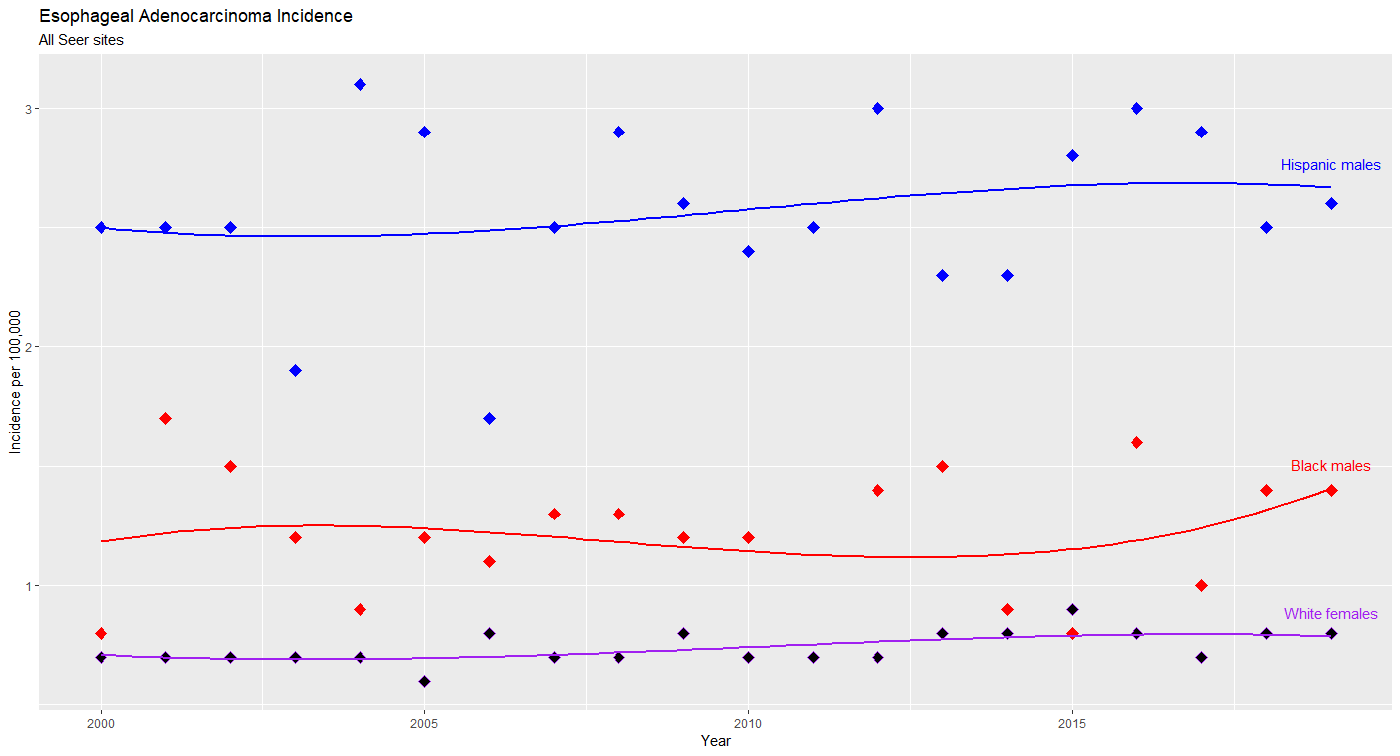Are EA rates resuming their upward trend?

A number of observers have noted that the incidence of esophageal adenocarcinoma (EA) appeared to plateau beginning in the early years of the millennium (e.g., Pohl, 2010; Cook, 2021.) To see whether this leveling off has continued, I examined the incidence of EA over the last 20 years (2000-2019) using the NCI SEER program’s most recent population based registry data ("SEER-17"), with data regarding Alaska, Hawaii and Rural Georgia removed due to the very small number of cases.
I found that the incidence in the highest risk demographic group, white males, appears to be increasing again (Figure 1.) Compared to the incidence in 2016 (5.60 per 100,000), the 2019 rates were approximately 10.7% higher (6.20 per 100,000). The smoothed data (line) shows a similar but slightly decreased change. In contrast, increases were not observed in Hispanic males, Black males or white females (Figure 2). The numbers of cases in other groups were not sufficient to look at short term trends. Continued monitoring of incidence is needed to determine if these last three years represent short term “noise,” or presage a longer term trend which would need to be taken into account in further understanding the epidemiology of EA and studying public health and clinical interventions.
A follow up post examines changes in incidence by SEER registry.

Notes on methods:
The “smoother” used in these figures is a 3rd degree polynomial. Using the non-parametric loess smoother results in quite similar results (not shown.)
Coming soon: Next, I will examine EA rates in white males by SEER registry to examine whether the increases are uniform across registries, or whether just a few are driving the changes.
Questions or comments? feedback (at) esocan (dot) org
References:
Pohl H, Sirovich B, Welch HG. Esophageal adenocarcinoma incidence: are we reaching the peak? Cancer Epidemiol Biomarkers Prev. 2010 Jun;19(6):1468-70. doi: 10.1158/1055-9965.EPI-10-0012. Erratum in: Cancer Epidemiol Biomarkers Prev. 2010 Sep;19(9):2416. PMID: 20501776.
Cook MB, Thrift AP. Epidemiology of Barrett's Esophagus and Esophageal Adenocarcinoma: Implications for Screening and Surveillance. Gastrointest Endosc Clin N Am. 2021 Jan;31(1):1-26. doi: 10.1016/j.giec.2020.08.001. PMID: 33213789.
Data specifications for SEER data pull:
Software: Surveillance Research Program, National Cancer Institute SEER*Stat software (www.seer.cancer.gov/seerstat) version 8.4.0.1.
Data: Surveillance, Epidemiology, and End Results (SEER) Program (www.seer.cancer.gov) SEER*Stat Database: Incidence - SEER Research Plus
Database: Incidence - SEER Research Plus Data, 17 Registries, Nov 2021 Sub (2000-2019) - Linked To County Attributes - Total U.S., 1969-2020 Counties
Statistic: Age-Adjusted Rates (Age recode with <1 year olds) (2000 US Std Population (19 age groups - Census P25-1130) standard)
Selection: Malignant Behavior, Known Age
Pop/Case: {Race, Sex, Year Dx.Race and origin recode (NHW, NHB, NHAIAN, NHAPI, Hispanic)} = 'Non-Hispanic White'
Case Only: {Site and Morphology.Site recode ICD-O-3/WHO 2008} = 'Esophagus' and AND {Site and Morphology.Histology recode - broad groupings} = '8140-8389: adenomas and adenocarcinomas'




